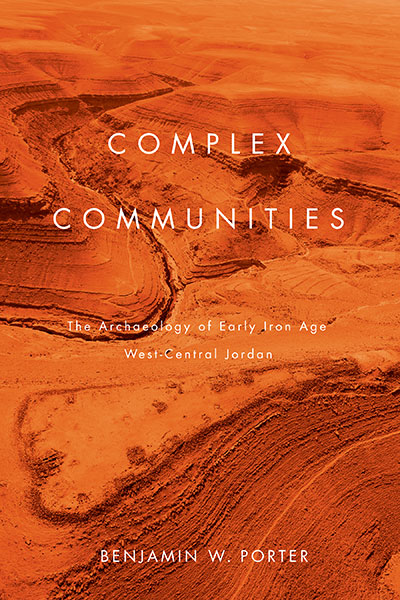COMPLEX COMMUNITIES
by Benjamin W. Porter
(Tucson, Arizona: University of Arizona Press, 2013), 203 pages, 5 maps, 14 illustrations, $50.00 (hardback), ISBN 9780816530328.

In his book, Complex Communities, Benjamin Porter examines how communities as social units adapt to environmentally marginal conditions. Transcending traditional categories of band, tribe, chiefdom, and state that often implicitly equate social complexity or equilibrium with success, he explores how communities practice resilience by varying subsistence strategies and social organization according to their needs. Porter focuses on communities in the semi-arid environment of west-central Jordan in the Early Iron Age (1250–1000 BCE), where rainfall farming is possible, but precarious. ese communities have often been viewed as precursors to the Moabite state featured in the Bible. However, Porter argues that these settlements were self-governing entities that would alternate between hierarchical and egalitarian formulations as the environmental and social conditions shifted.
Complex Communities draws upon a wide dataset, including the built environment, small finds, botanical remains, and ceramic technological analyses such as petrography. These domestic materials show how community practices endure even when large-scale data, such as settlement patterns, shift. Analyzing these micro-data makes it possible to observe a community’s resilience, which may require significant changes in subsistence strategy alongside the continuation of identity construction practices such as feasting. This promising approach is limited, however, by the existing data, since extensive excavations of the Iron Age Levant tend to focus on architecture over micro-data. Though Porter offers detailed case studies for measuring, producing, and managing community, the very flexibility of this analytical category can make it difficult to precisely pin down. This is a double-edged sword, since the fuzzy margins that make this concept nebulous also enable the plasticity that is lacking from the usual, but often criticized, categories of band, tribe, chiefdom, and state. Overall, Porter provides a roadmap to discern communities, which can be applied more fully in the Levant as excavations continue, and can be broadly utilized in regions throughout the world.
Porter’s research provides relevant data for modern climate change debates, as it explores how humans can successfully adapt to shifting environmental conditions. In addition, Complex Communities proposes a model for how social change can be understood as strength or, minimally, as a value-neutral adaptation to changing conditions. This provides a counter-narrative to the popular concept of collapse, wherein decreasing social complexity is viewed as societal failure.
This book will appeal especially to professional scholars and graduate students of Near East archaeology, anthropology, resilience studies, and historical ecology, as well as advanced undergraduates and those who are interested in delving deeper into how humans adapt to and impact their environment.
Reviewed by Susannah G. Fishman, Ph.D. candidate, Department of Anthropology, University of Pennsylvania.
